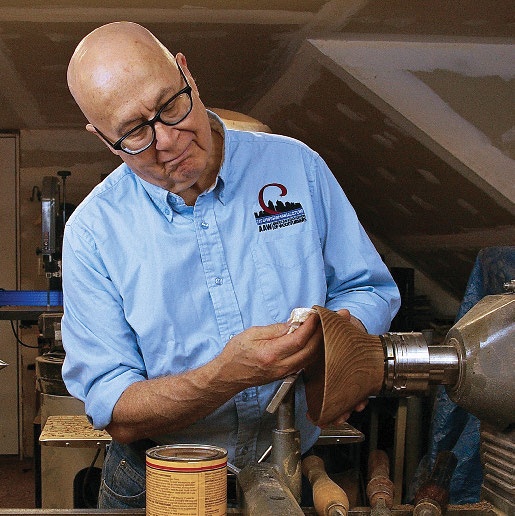Columbia College | Columbia University in the City of New York
David Heim ’68 Turns Wood and Phrases
If David Heim ’68, JRN’75 were to see you cutting down a tree in your yard, he might politely ask you for some of the wood to turn. He likes maple “because it’s easy to work with and it finishes beautifully.” Cherry, too. He avoids tropical hardwoods, many of which contain the mineral silica, because, he says, “they’re murder on tools” — and they’re expensive.
Turning is shorthand for woodturning, and Heim has been an avid practitioner for almost 15 years. The craft involves attaching a rough piece of wood to a lathe, which rapidly spins the wood while the turner uses a sharp chisel to shape it. Heim made his first bowl in 2003. Curious about turning, he visited a lumberyard, bought some basswood and brought it to his father-in-law’s workshop. “He’s not a bowl-turner, so he didn’t have the right tools, but I managed to make a bowl-shaped object nonetheless,” Heim says. He was hooked.

David Heim ’68
Today, Heim — who lives in Oxford, Conn., with his wife, Kate, and 34-year-old son, Theodore — spends 15–20 hours a week in a small shop above his garage (now equipped with all the right tools, including three lathes, a table saw, a drill press and a bandsaw). Bowls are his favorite things to make, and he points to one in particular — made of beech — as an example of what he loves about turning. The surface is covered with jagged, dark lines and looks like an old map of the world. “I knew that the wood was spalted — used as a cafeteria by various fungi — but I had no clue it would produce such a wonderful pattern until I had shaped the bowl,” Heim says. “Surprises like that keep me going.”
Heim sells some of his creations on Etsy (etsy.com/shop/davidheim), offering bowls, serving platters, shaving kits, vases and other items. His is a hobbyist operation, though his work doesn’t take him far: He freelances for woodturning publications and has written two books: Woodturning Patterns: 80+ Designs for the Workshop, Garden, and Every Room in the House (2017) and SketchUp Success for Woodworkers: Learn the Basics for Quickly and Accurately Creating 3D Designs, due out this year. Now retired from a full-time career, Heim spent 28 years at Consumer Reports in various editor roles before his love of his craft took him to Fine Woodworking from 2005 to 2009. (His journalism roots lie with Spectator, for which he was managing editor and even helped to scoop The New York Times with a special issue on the Vietnam draft.)
Heim, who is on the Board of Directors of the American Association of Woodturners, has different ways of working with words and wood. “When I’m at the computer, writing something or editing, I’ve got a pretty good idea of what the finished product will be, and I have a pretty good idea of the path I have to follow,” he says. “If I mount a piece of wood on the lathe, I have a vague idea of what’s going to happen, but I have to let the wood guide me. I can’t force a shape into a piece of wood sometimes because there’s a flaw in the middle of the piece of wood and I have to work around that.”
Kate Antoniades is a freelance writer and editor in Rochester, N.Y.
Issue Contents
Published three times a year by Columbia College for alumni, students, faculty, parents and friends.
Columbia Alumni Center
622 W. 113th St., MC 4530, 6th Fl.
New York, NY 10025
212-851-7852
cct@columbia.edu
Columbia Alumni Center
622 W. 113th St., MC 4530, 4th Fl.
New York, NY 10025
212-851-7488
ccalumni@columbia.edu

